 "user314" (user314)
"user314" (user314)
10/28/2020 at 11:00 • Filed to: flightline, Planelopnik, planelopnik history, Helicopterlopnik
 5
5
 4
4
 "user314" (user314)
"user314" (user314)
10/28/2020 at 11:00 • Filed to: flightline, Planelopnik, planelopnik history, Helicopterlopnik |  5 5
|  4 4 |
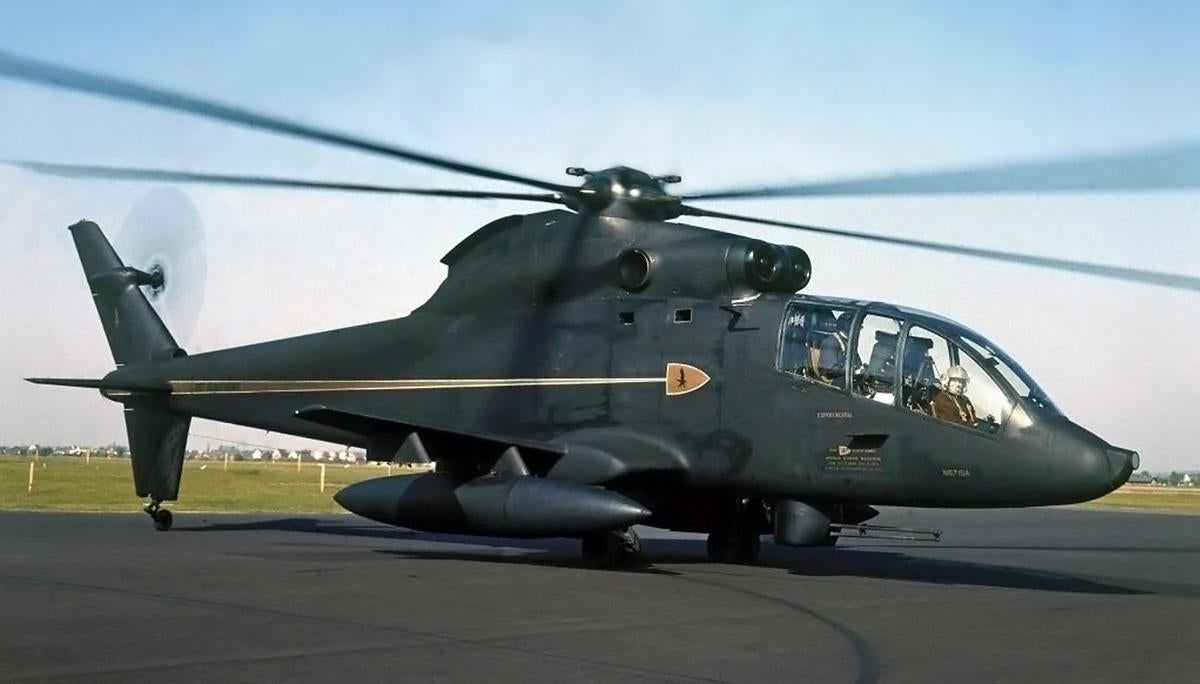
The Sikorsky S-67 prototype
In 1964, the US Army issued a Request for Proposals for the Advanced Aerial Fire Support System (AAFSS) program, with the goal of creating the first clean-sheet attack helicopter design. Lockheed submitted its !!!error: Indecipherable SUB-paragraph formatting!!! , a !!!error: Indecipherable SUB-paragraph formatting!!! , while Sikorsky countered with the S-66, which was also a compound design, but had the unique Rotoprop™, which would act as a tail rotor in hover and low speed flight, but would swivel 90° to become a pusher prop for high speed flight.
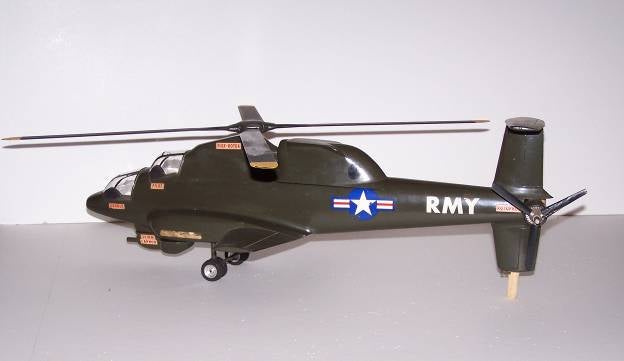
S-66 model with Rotorprop in hover mode
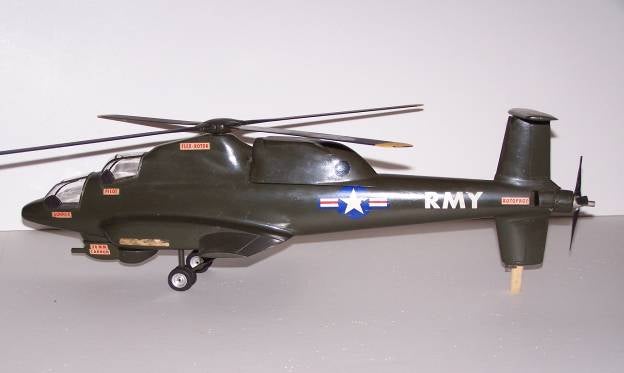
Model in high speed mode
The Army judged the CL-840 to be the winner, citing it as a lower technical risk, as well as cheaper and faster to produce. The initial roll-out ceremony for the newly-christened YAH-56 Cheyenne was held on 3 May 1967, with flight testing beginning in September. A n initial production order of 375 copters was approved on 8 January 1968. Flight testing soon uncovered instability and vibration issues, however, culminating in the fatal crash of the 3rd prototype during a test flight on 12 March 1969. The Army issued a cure-notice ( A list of problems that are required to be addressed prior to production.) to Lockheed on 10 April 1969, citing 11 technical problems, and unsatisfactory progress on the program. The main issues were the half-P hop ( a vibration that happens once per two main rotor revolutions, where P is the rotor’s rotational speed) issue, and the aircraft gross weight exceeding program requirements. In respons e, Lockheed proposed an “improved flight control system” to reduce rotor oscillations, along with steps for removing excess weight and addressing other minor issues in production helicopters, all of which the Army felt would increase costs and production time. As a result, the production contract was canceled on 19 May 1969, though the development contract was maintained in hopes that the AH-56's issues could be cured.
Seeking to capitalize on Lockheed’s woes, Sikorsky offered first an armed version of the SH-3 Sea King, then an entirely new design, the S-67 Blackhawk . Design work on the Blackhawk began in 1969, with first flight on 20 August 1970.
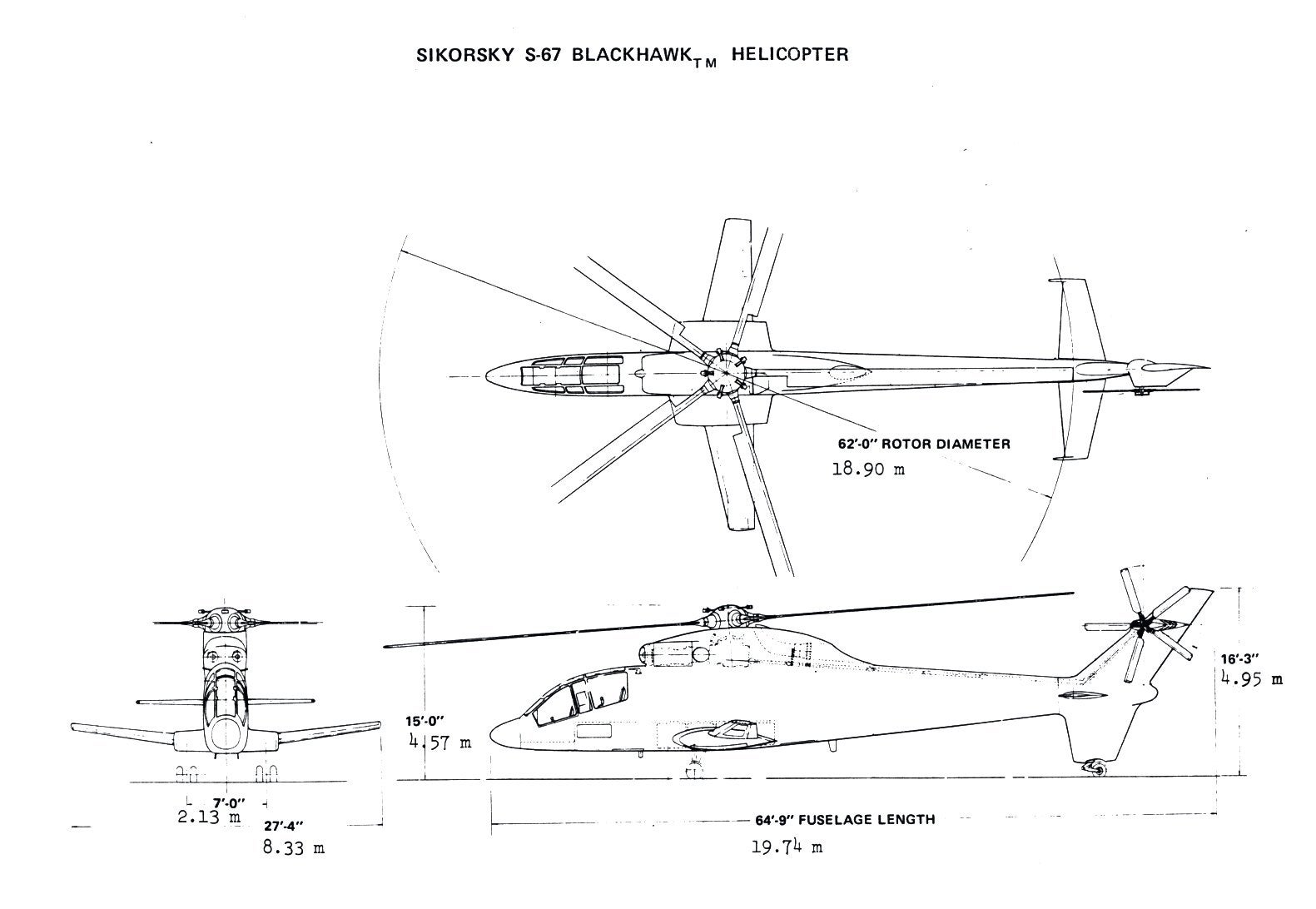
Orthograph of the S-67
Dispensing with the Rotoprop from the S-66, the Blackhawk was a conventional design, though it was fitted with stub wings for lift and weapons carriage, and unusually for an American design, could transport 6-8 troops. The five-bladed main rotor was taken from an !!!error: Indecipherable SUB-paragraph formatting!!! , modified to have a hub fairing, swept main rotor blade tips and a special “alpha-1" linkage which was added to the main rotor controls to increase collective pitch sensitivity and so extend the collective pitch range. These measures, along with retractable landing gear granted the S-67 a max speed of 168kts (clean, at 18,000'), and during testing the S-67 established two E-1 class world speed records on 14 December 1970 by flying at 348.97 km/h (217 mph) over a 3 km (1.9 mi) course, and 355.48 km/h (221 mph) on 15 to 25 km (9.3 to 16 mi) course on 19 December 1970, with both records standing for eight years. The S-67 was also maneuverable , performing a series of aerobatic maneuvers during its various marketing tours, including rolls, split-S, and loops. The Blackhawk prototype was fitted with a moving map display, a hands-on-collective radio tune control, and night vision systems . Its armament included a !!!error: Indecipherable SUB-paragraph formatting!!! (TAT-140) with a three barrel 20 mm cannon, and could carry 16 !!!error: Indecipherable SUB-paragraph formatting!!! , 70 mm rockets, or AIM-9 Sidewinder air-to-air missiles .
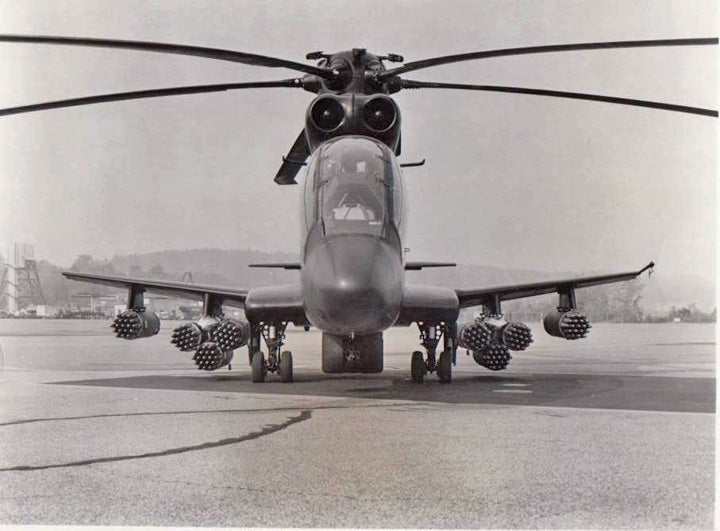
The S-67 armed with 70mm rocket pods
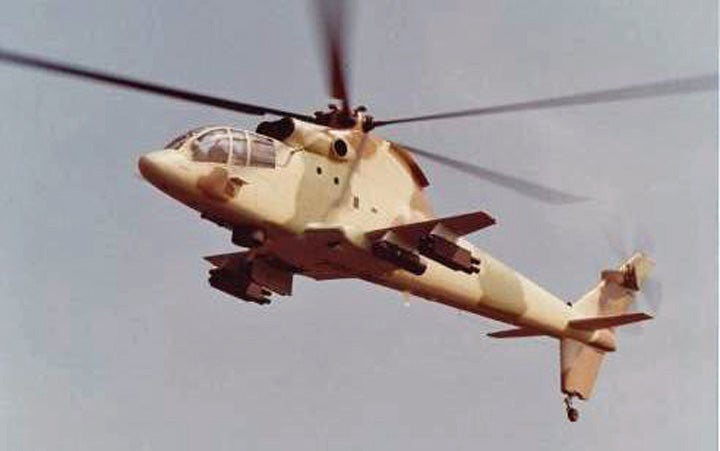
The Blackhawk on a demonstration tour, painted in camouflage and carrying TOW missile pods
The S-67 was also fitted with speed brakes, a first for a spin-wing design, which were expected to increase stability and accuracy during combat maneuvers and attack runs.
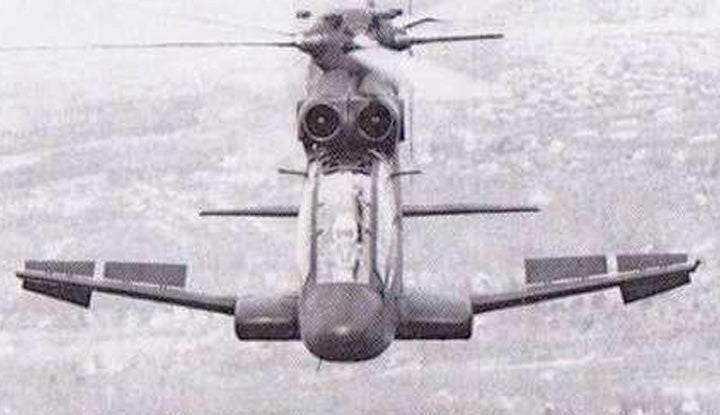
S-67 with speed brakes opened
The vertical stabilizer was designed to unload the tail rotor at cruise speed, decreasing power requirements and increasing fuel savings . The fin was also sized to permit return to base in case of loss of the tail rotor. The horizontal stabilizer was a “flying tail”, with variable incidence to improve agility, reduce rotor stresses in maneuver, and to control fuselage pitch for alignment with targets. The stabilator was coupled to the control system and could be trimmed electrically to also provide center of gravity adjustments.
Sikorsky also anticipated scout and transport applications, with the aft compartment able to be fitted with surveillance equipment, or the combat equipment (including the wings, if needed) able to be removed.
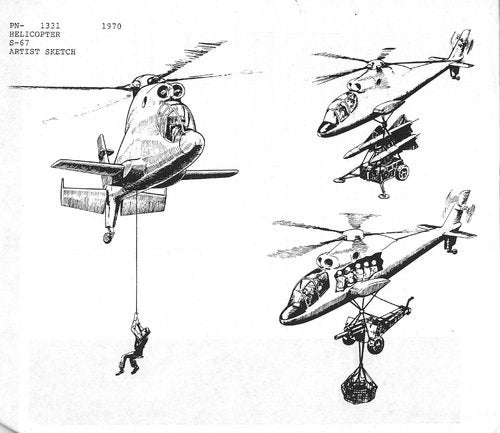
Artists’ illustration of S-67 variants carrying out CSAR and transport missions
In 1972, the S-67, along with Bell’s Model !!!error: Indecipherable SUB-paragraph formatting!!! , were subjected to flight evaluations by the US Army. Neither were selected to replace the YAH-56, with the Army cancelling the AAFSS entirely, choosing instead to begin a new program, the !!!error: Indecipherable SUB-paragraph formatting!!! (AAH), which eventually led to the AH-64 Apache.
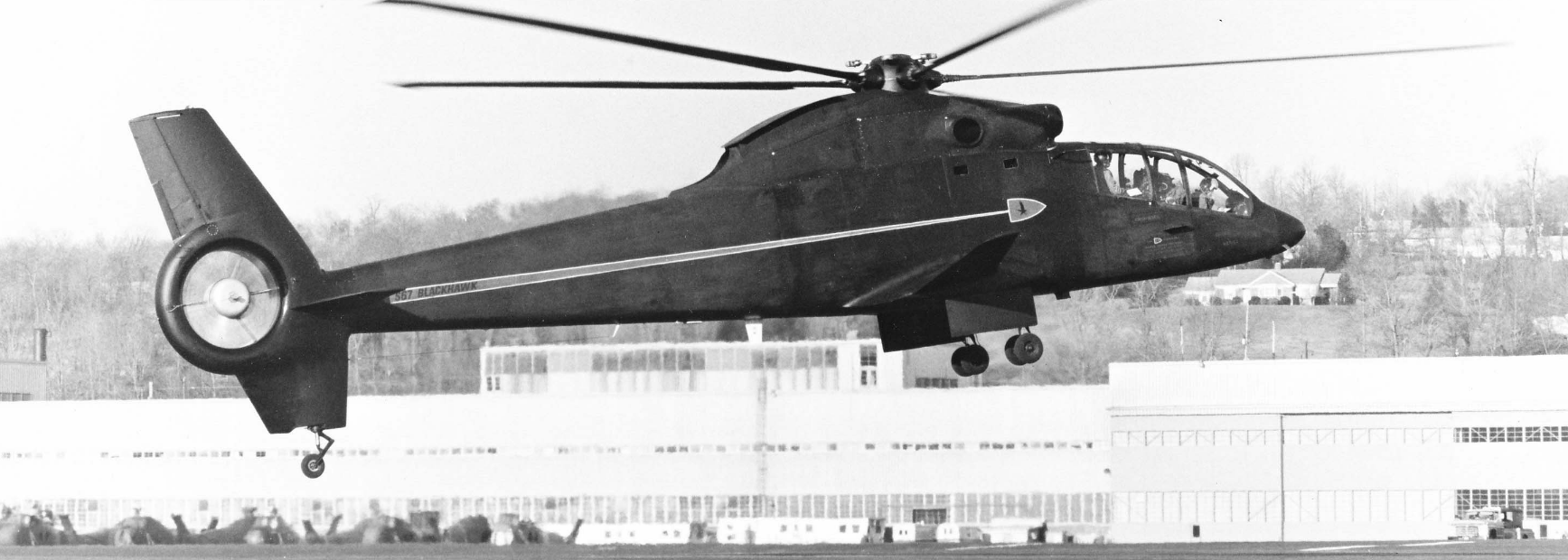
The S-67, refitted with a Fenestron tail
As part of Sikorsky’s R&D trials, the S-67 was fitted with a Fenestron tail in 1974. During these tests, the aircraft reached 230mph in a dive. The conventional tail rotor was restored in August, and in September it was performing at the Farnborough Air Show when, during a low-level roll, it struck the ground and burst into flames, killing both pilots. Development work on the S-67 design ceased after the accident.
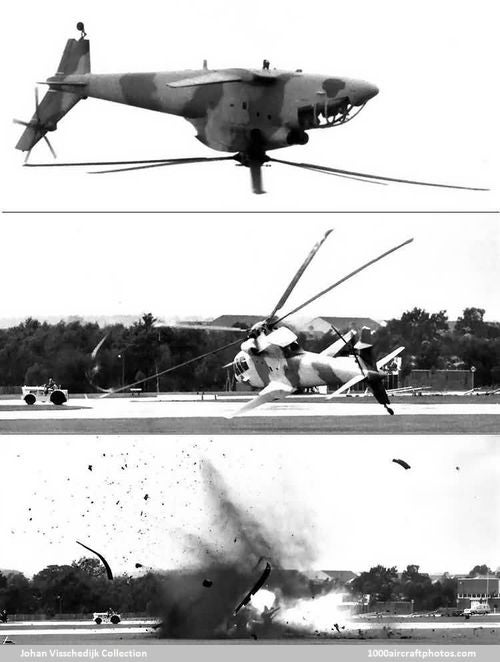
Three photo sequence of the S-67 crash
 ttyymmnn
> user314
ttyymmnn
> user314
10/28/2020 at 11:43 |
|
An attractive helicopter. Seems like it might have had some potential, particularly in the troop carrying role.
 facw
> ttyymmnn
facw
> ttyymmnn
10/28/2020 at 11:55 |
|
I’m not sure an American Hind would really be that useful. It’s a pretty helicopter though.
 InFierority Complex
> ttyymmnn
InFierority Complex
> ttyymmnn
10/28/2020 at 12:05 |
|
It’s kind of a parallel evolution with the Hind. Looks like the U S prefered more specialised airframes than a jack of all trades approach.
 KingT- 60% of the time, it works every time
> user314
KingT- 60% of the time, it works every time
> user314
10/28/2020 at 12:21 |
|
Sirkosky is developing the Raider now, looks like a development on the Rotoprop concept
https://www.lockheedmartin.com/en-us/news/features/2020/raider-x-enters-fara-prototype-phase.html